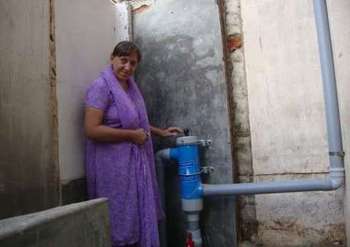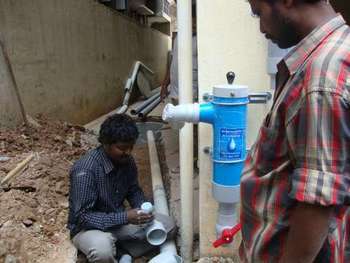Plumbers make hay while the deadline for RWH installation expired recently and then was extended till August 15th. In the mad rush to get things done, the public are also facing problems. Plumbing issues, improper planning, lack of interest and awareness are few of the points contributing to future issues.
In many cases, citizens are not aware of what is going to be done. When they leave it all to the plumbers, without first understanding how it works, there might be issues, says Shankar Rao, manufacturer of RWH filters and a solution provider.

Filter maintainance easy, says Anna Srinivas from Girinagar. Pic: Divya Sharma
Sometimes it is the absence of house owners that could be the root of issues. "They hand over the grill gate keys and we do the job, as decided earlier. When both husband and wife are working, they cannot oversee the work all time. Senior citizens take interest in the work and will be available", says another vendor Sridhar, based in south Bangalore. Which could mean the plumbers or the supervisor will have to decide when it comes to decision making.
"Filter maintenance is the primary area where one could foresee problems. First flushing the filter, then periodical cleaning – this requires some time", says Avinash Krishnamurthy of Biome Solutions. (Biome is a commercial offshoot of the non-profit Rainwater Club.)
"Socially responsible is fine, but who sets the rules for practicing vendors?" wryly asks M Vishwa Shastri, resident of Banashankari I stage. "I have seen well diggers coming around here saying they will do rainwater harvesting. Even meter readers offer to help. They don’t have any certificate, but that anyway is not mandatory. There are all chances these people don’t stick to regulations of pit dimensions."
For its part, BWSSB, the city’s water and sewerage utility whose mandate is to enforce RWH installations as per the new law, says you can get RWH done by any plumber. If one is interested, irrespective of their background, they can get the free training by BWSSB. So far, a total of 950 vendors have been trained, claim the officials. Sessions are conducted once a month or if there are 30-35 registrations. The training is structured to make an individual aware about RWH, its working concept and the mandatory regulations of recharge pit area and other numbers.
BWSSB’s website has the list of trained people. If anybody finds a problem with a vendor, they can complain to BWSSB and they will black mark the vendor in their list on the website. BWSSB also has a helpline number in case of any queries.
A brief interview with Avinash Krishnamurthy of Rainwater Club (also Biome Environmental Solutions)
What is a recharge pit? Is it the same as a recharge well?
A recharge pit is a hole dug in the ground. Usually it is filled with gravel or jelly to give it structural strength. A recharge well is not filled with gravel. It needs concrete rings installed in it to stabilise its walls.
What should be the depth of a recharge well/pit?
If you want to have effective recharge for Bangalore conditions, a 15-20 feet depth is needed. (Provided you do not hit rock before that depth). If you hit water while digging the pit, you need to ask the workers to be careful while they continue digging. The diameter of the pit you choose depends on two things: space available and the quantity of water you will send in. A 3 feet dia X 20 feet pit will ‘hold’ around 4000 litres (for recharging the ground). A 5 feet x 30 feet structure can hold 16000 litres.
What are the legal guidelines and their implication for recharge pit sizes?
The law states that you need to store or recharge 20 litres for for every sq.m of roof area and 10 litres for every sq.m of non-roof (ground surfaces such as parking, backyard) area. This is for plot sizes of 40×60 or more. For e.g. if your home has about 100 sq.ms of roof area, and about 50 sq.ms of non-roof area, then you will need to create capacity for at least 2500 litres of water. If you are using a 1000 litre tank to store rainwater for immediate use, you can connect the overflow to a 4000 litre (3 feet x 20 feet) recharge well.
The devil seems to be as always in the details. "Sometimes when the plumbing is old and we explain the need for replacing entire catchment area pipes, the owners are unwilling to go for the extra expense. They ask us to just lay the new pipes only wherever necessary. This could definitely mean there will be problems after one rainy season", says Senthil Kumar, a plumber in South Bangalore who works for a vendor.
Interestingly, Kumar himself is a not RWH solution provider. "I have no time for the pre-process talks. It would mean meeting clients, explaining the RWH process – at the cost of my labour time of about 2 days. So, I tied up with a vendor who does all the preliminary talks and negotiations. I just do the job. "
Krishnamurthy of Biome says, "It is the attitude correction we need to do. Many house owners are not convinced about the rule. They are getting it done, just for the sake of deadline."
And what could be the cost variations for a job? "I got 3 quotations for my house RWH, and they were very different. The lowest and highest rates varied about 200%", says M Nirmalan, resident of Girinagar. "I enquired some more and finally decided upon the vendor after being convinced about the working of the concept from him. I am happy with the job done as of now. Any problems, I think, could appear only after one or two seasons of rainfall".

Groundwater recharge pit, work in progress at a home in Malleswaram. Pic: Divya Sharma
"Care has to be taken if they are doing borewell recharge. All rain water from the catchment area should not be directly taken to the borewell", explains BWSSB engineer Manjunath. Underground water table could be made of hairline thin rock layers and this might be damaged with heavy water flow. "Also, when they choose the filters, it should be based on terrace size and cleanliness of terrace. If roof top is as clean as the house floor, a filter is not necessary. It will matter if you are going to use the water for drinking. All these problems are fixable", he elaborates.
So far, only one complaint has been received about a working borewell being spoiled. This problem has been fixed and our engineers have done the spot inspection, he clarifies Manjunath.
"Each site is unique and no generalisation about cost can be done. To minimise any setbacks, vendors should educate the owners – make them ‘water literate’", sums up Sridhar.
With the deadline of RWH implementation being pushed further, there is more time to get to know your RWH system. Owners being aware of the theory and process will go a long way in having problem-free RWH systems. ⊕
The article is good, but it uses RW Harvesting and Recharging interchangeably and in a confusing way. Rain Water Harvesting is Collecting and Storing rainwater in a Tank or Pond for future use, you get the direct benefit from this. Recharging on the other hand is allowing water to percolate into soil so as to reach water table, instead of flowing away in drains, this is beneficial for the community as a whole.
Also recharging a Bore incorrectly, can contaminate the water table is not very preferable.
The best is to try and store rain water in a tank for later use and allowing the overflow into a percolation tank.
One wonders how-many Bangalore homes actually have space to build the System?
May be Rainwater recharge certificates should be given out and can be bought by houses with no Space. This money can be used to build recharge systems in public areas.
Also Storm water drains can also be designed with Inbuilt percolation systems. BWSSB should make that a mandatory feature for future Storm Drains.